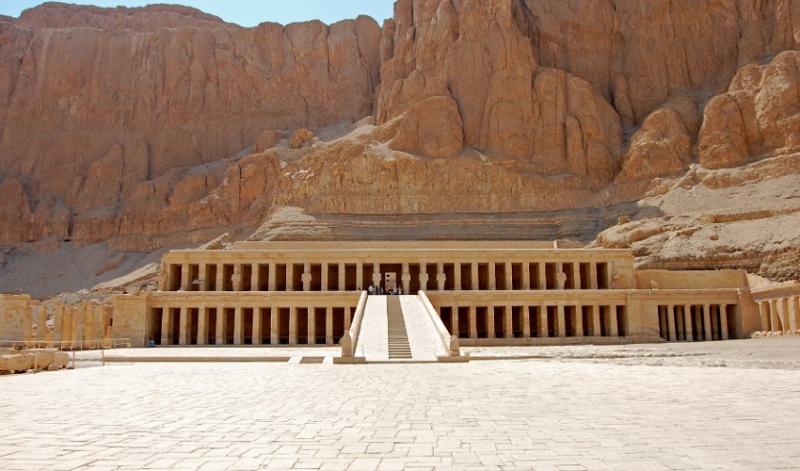Hatshepsut temple Luxor attraction
Hatshepsut was the fifth pharaoh of the Eighteenth family of Egypt. Hatshepsut was the second historically-approved female pharaoh. Hatshepsut was a female pharaoh of Egypt. Hatshepsut ruled Egypt between 1473 and 1458 B.C. Her name means “foremost of noblewomen".
With the death of Thutmose II, the throne fell to Thutmose III, a step-son and nephew of Hatshepsut. He was, however, a child and unable to rule Egypt, leaving Hatshepsut to serve as regent. She did this for three years until, for reasons unknown, she became a pharaoh in her own right (although technically a co-ruler with Thutmose III).
Her rise to power and her bloodline was infallible because she was the daughter, sister, and wife of a king. Hatshepsut was the wife of Thutmose II, Thutmose III’s father. She reigned longer than any other woman of an indigenous Egyptian dynasty.
Hatshepsut was the only child of Thutmose I and his Chief wife, Ahmose. Her husband Thutmose II was the son of Thutmose I and a his wife Mutnofret who was the secondary wife. Hatshepsut and Thutmose II had a daughter named Neferure. After having their daughter, Hatshepsut could not bear another children.
Hatshepsut’s reigned was peaceful she launched a number of building projects at the temple complex of Karnak temple and the Hatshepsut temple at Deir el-Bahari at Luxor.
Hatshepsut took on a full throne name, and statues were created depicting her as a male king, right down to the beard. However, Hatshepsut did allow some feminine traits to come through. “Although for most of her reign Hatshepsut was depicted with the traditional image of a male king, the names that she used as king were formed with grammatically feminine participles, thus openly acknowledging her female status”.
"Even though Hatshepsut was portrayed as a man in her statues, Hatshepsut gave a nod to her female physique by making her waist narrower, The most important evidence of this the a wooden statue at Abydos that may be of Hatshepsut, notes that her Hatshepsut’s waist was depicted as being somewhat slimmer than her male counterparts.
When archaeologists excavated the Hatshepsut temple in the 19th century, they found shrines dedicated to Hathor and Anubis. They also found, on the lowest terrace, a relief showing Hatshepsut as a sphinx and another “describing the quarrying and transportation of two granite obelisks from the quarries at Aswan.”
Hatshepsut sent delegation in commercial missions to the land of Punt also known as “God’s land” . Land of Punt located somewhere on the northeast coast of Africa. This delegation was a key foreign relations triumph during Hatshepsut’s reign and it returned bearing 31 live myrrh trees, Its roots were carefully kept in baskets for the duration of the trip. This attempt was the first recorded to transplant foreign trees. Hatshepsut had these trees planted in the courts of her mortuary temple compound. The delegation also returned with a number of other gifts from Punt like frankincense. Hatshepsut would grind the charred frankincense into kohl eyeliner. This is the first registered use of the resin.
Although of her successful reign, and a burial in the Valley of the Kings, her monuments would be defaced after her death by her co-ruler and step-son/nephew Thutmose III.
Thutmose III, who was technically co-ruler with Hatshepsut, succeeded Hatshepsut after her death.
Although Hatshepsut buried in the Valley of the Kings, her memory was not honored. Soon after her death in 1457 B.C., Hatshepsut's monuments were hit , her statues dragged down and smashed and her image and titles deformed. May be Thutmose III try to gain credit for some of the successes Hatshepsut experienced during her rule. by Survey all apparent references to his co-ruler Tuthmosis could incorporate her reign into his rule to become Egypt's greatest pharaoh.
in 2007, researchers announced that Hatshepsut’s mummy had been identified in tomb in the Valley of the Kings. The scan of a single tooth in a box with Hatshepsut’s name on it perfectly matched a tooth socket in the mummy’s jaw .Hatshepsut’s mummy notes that she was around 50 when she died, balding, suffering from diabetes and wearing black and red nail polish. Hatshepsut also Love perfume.
Now let's talk about Hatshepsut temple :-
At Deir Al Bahri, the eyes first focus on the dramatic rugged limestone cliffs that rise nearly 300m above the desert plain, only to realise that at the foot of all this immense beauty lies a monument even more extraordinary, the dazzling Hatshepsut Temple. The almost-modern-looking Hatshepsut temple blends in beautifully with the cliffs from which it is partly cut – a marriage made in heaven.
Continuous excavation and restoration since 1891 have revealed one of ancient Egypt’s finest monuments which was Hatshepsut temple. It was approached by a grand sphinx-lined r, when the court was a garden planted with exotic trees and perfumed plants, and when it was linked due east across the Nile to the Karnak Temple.
Hatshepsut temple was vandalised over the centuries: Tuthmosis III removed his stepmother’s name whenever he could; Akhenaten removed all references to Amun, and the early Christians turned Hatshepsut temple into a monastery, Deir Al Bahri (Monastery of the North), and defaced the pagan reliefs.
Deir Al Bahri has been designated as one of the hottest places on earth, so an early morning visit is advisable, also because the reliefs are best seen in the low sunlight. The complex is entered via the great court, where original ancient tree roots are still visible. The colonnades on the lower terrace were closed for restoration at the time of writing. The delicate relief work on the south colonnade, left of the ramp, has reliefs of the transportation of a pair of obelisks commissioned by Hatshepsut from the Aswan quarries to Thebes, and the north one features scenes of birds being caught.
Mobile : +2010014222529
+201033358596
E-mail : [email protected]
Web site: www.planegypttours.com



